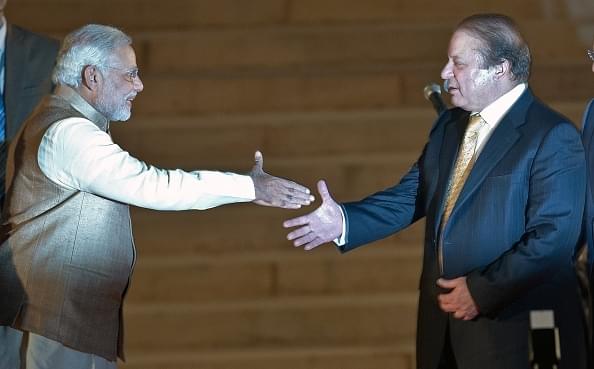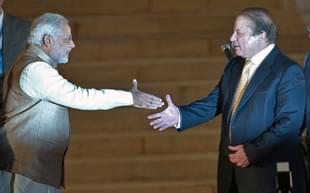Magazine
Why India-Pakistan Relations Continue To Be In Such A State Of Despair
Ashok Sajjanhar
Feb 09, 2017, 04:01 PM | Updated 03:26 PM IST
Save & read from anywhere!
Bookmark stories for easy access on any device or the Swarajya app.


Professor Sumit Ganguly holds the Rabindranath Tagore Chair in Indian Cultures and Civilizations and directs the Center on American and Global Security at Indiana University, Bloomington, USA. A specialist on international and comparative politics of South Asia, he has previously taught at several universities and authored/edited 20 books on the contemporary domestic and international politics of South Asia. Deadly Impasse: Indo-Pakistani relations at the Dawn of a New Century has hence understandably aroused considerable interest and raised expectations. Professor Ganguly does not disappoint either in the succinctness and clarity of his presentation or in the focus and precision of his analysis.
In the slim 176-page volume, Ganguly traces the history of relations between India and Pakistan since 1947. He has tried to determine whether bilateral relations can be considered as being driven by the tenets of the classical ‘’security dilemma’’ or should India use the principle of ‘’deterrence by denial’’ to regulate its ties with Pakistan.
The term ‘’security dilemma,’’ also referred to as the ‘’spiral model,’’ coined by the German scholar John H Herz in his 1951 book Political Realism and Political Idealism, refers to a situation in international relations in which actions by a state intended to heighten its security, such as increasing its military strength or making alliances, can lead other states to respond with similar measures, producing increased tensions that create conflict, even when no side really desires it. A deterrence model assumes that one of the two states involved in an adversarial relationship harbours hostile intentions towards the other and a war can only be averted through the adoption of appropriate military strategies that would raise the cost of aggressive behaviour.
Ganguly proves beyond any shadow of doubt that the dynamic underlined by security dilemma does not govern relations between India and Pakistan. He cites several instances over the last 70 years in which India has gone out of its way to reassure Pakistan that it does not harbour inimical intentions. Unfortunately, none of these has had any positive effect. The two countries have gone to four wars (1947-48, 1965, 1971 and the Kargil conflict in 1999) and innumerable crises but have not been able to arrive at a durable solution.
The author states that right from their independence, relations between the two countries got mired in the territorial dispute over the state of Jammu and Kashmir (J&K). He disputes the contention of Ayesha Jalal who has suggested that India’s size and initial intransigence gave rise to Pakistan’s fears, as also of Aqil Shah who argues that the Pakistani military establishment continues to stoke such fears for advancing its own parochial interests. Ganguly finds himself in agreement with C. Christine Fair who argues that Pakistan is not a security seeking state but a ‘’greedy’’ state which is an extension of its national ideology.
Ganguly contends that Pakistan is a revanchist state, which is determined to acquire territory from India through war or by fomenting discontent and violent uprising in J&K. Pakistan can be seen as a revisionist state while India is a status quo power. Pakistan remains unalterably committed to changing the territorial status quo regardless of Indian behaviour. India is a declared enemy state for Pakistan but India does not look upon Pakistan in those terms and always tries to normalise and have cooperative and friendly relations with that country. India has never sought to pursue territorial aggrandisement through aggressive means. It has always maintained that a stable, peaceful and prosperous Pakistan is in India’s interest.
The period that receives particular focus in this book is the decade from 1999 to 2009. This period covers the Lahore peace process; the Kargil war and its aftermath; the 9/11 attacks; attack by Lashkar-e-Tayeba (LeT) and Jaish-e-Mohammed (JeM) operatives on the Indian Parliament in 2001; the Agra Summit; commencement of the composite dialogue in 2004; the 26/11 attack; the meeting at Sharm-el-Sheikh and several interactions at senior political and official level between the two countries.
The book deals not only with relations between India and Pakistan but also devotes a full chapter to Pakistan’s search for strategic depth in Afghanistan and attacks engineered by it on India through its proxies like LeT, JeM and others. For a wide-ranging and fairly comprehensive account of evolution of relations between India and Pakistan, this book is extremely valuable and useful.
Where it falls somewhat short of expectations is in terms of policy prescriptions contained in the last chapter. How should India deal with Pakistan which is determined to alter the status quo in J&K and evict India from Afghanistan? Pakistan is keen to be instrumental in establishing a government in Kabul which is dependent on or subservient to it. Ganguly proposes a policy of ‘’deterrence by denial’’ for India which would entail the following components:
India should maintain adequate forces in Kashmir to ensure that it can thwart any Pakistani attack.
- India should ensure sufficient vigilance along the border and not slacken its intelligence collecting efforts.
- India should maintain its counter-insurgency efforts within Kashmir to ensure that any insurgency from across the LoC is suitably contained. In addition, India should undertake a string of imaginative policy initiatives to address a range of underlying grievances of the Kashmiri people.
- India should actively address the ‘’growing problem’’ of radicalisation of Muslim youth in the country.
Ganguly also recommends that India should desist from embarking on strategies like the ballistic missile defence (BMD) programme which could be considered to be provocative by Pakistan.
The above recommendations contain germs of several problems within them. It needs to be understood that India’s BMD programme is designed to enable it to protect itself against both Pakistan and Chinese nuclear arsenals. India cannot design its defences to cater only to the threat from Pakistan and not from China. In fact, China has emerged as India’s major adversary in recent years. Moreover, India is the best judge to determine what will be sufficient for its defences. It cannot allow Pakistan to have a veto on the nature and level of defences that India should maintain. The politico-strategic argument given by Ganguly is less than convincing. What he seems to suggest is that India should prepare its defensive capabilities at a level so that it can withstand an attack only from Pakistan while disregarding any aggression that it might have to face from China. Such action will keep India knowingly vulnerable to an attack from China. This is quite unacceptable.
Ganguly suggests that India may have to consider granting more autonomy to J&K in an attempt to assuage long-term resentments. In the next sentence, he adds, ‘’This concession in all likelihood, will not satisfy Pakistan.’’ This assertion begs two comments. Firstly, Pakistan’s satisfaction in this context has no relevance whatsoever. Pakistan has no locus standi in the matter. Any initiatives taken by the Indian government in this regard are for its own citizens in which Pakistan has no role to play. Pakistan is an outsider who cannot be given a right to interfere in India’s internal affairs. Secondly, the idea of greater autonomy has been bandied around for quite some time but no concrete thoughts as to how this should be done have been advanced. Even the Kashmiri people have not been able to put forward any specific, detailed suggestions in this regard.
The issue of radicalisation that has been raised is a challenge that confronts the whole world. India’s track record in this context is enviable and commendable. The number of Indian Muslims who have responded to the call of the Islamic State (IS) or other international jihadi groups can be counted on the fingertips. The number is minuscule compared to western countries as well as west and central Asian countries from where youth in hundreds and thousands have gone to join IS. India of course needs to be vigilant, and needs to take all appropriate measures for imparting training and skills, and providing jobs to the Muslim youth so that they become a part of the national mainstream.
In this regard, reference has been made by the author to the so-called “pogrom” in Gujarat in 2002. This seems to have had no impact on the Muslim youth’s proclivity to become radicalised over the last 15 years. The policy adopted by the current government of “sabka saath, sabka vikaas” and several fresh initiatives adopted in this context should be able to make a significant dent in providing jobs and a life of dignity to Muslim youth in the country.
Going forward, Ganguly has provided two likely scenarios. One is that over time the material gap between India and Pakistan will be so great that India will be able to cope with the provocations regardless of the strategy that Pakistan employs. Pakistan will remain an irritant but the gap in capabilities will be so huge that Pakistan’s attacks will appear as mere pin pricks. The other possible scenario could be the result of a substantial “exogenous or endogenous shock” that will undermine the privileged status of the Pakistani security establishment. In the current scheme of things, neither of these two possibilities appears feasible.
After the investment of $46 billion in the China-Pakistan Economic Corridor (CPEC), it is unlikely that the material gap between India and Pakistan will become quite that insurmountable in the foreseeable future. It also needs to be noted that Pakistan has been so emboldened to continue with its terrorist attacks against India with impunity because of the political and strategic support it has been receiving from China which has even gone to the extent of exercising its veto on putting a ban by the United Nations on the well known terrorist Masood Azhar, JeM chief and mastermind of several terrorist attacks against India. In addition, it will not be politically feasible in a democratic country like India to continue to bear the killings and destruction of its strategic assets by Pakistani-aided terrorists without offering a robust response.
The recent surgical strikes are only one of the many alternatives that can be employed to inflict pain on the terrorists and their masterminds. Moreover, it does not appear that the support base of Pakistan’s army and intelligence establishment will diminish anytime soon. On the contrary, over the last two years, the Pakistan army has gained in prestige and clout in the country after the launch of the Zarb-e-Azb operations and action against terrorists targeting Pakistani assets and security establishment.
In addition to dealing with the theoretical underpinnings of Pakistan’s behaviour, the author could also have dealt at some length with the total control that the Pakistan army and ISI have on the country’s policy on relations with India (as well as Afghanistan, USA and nuclear policy). It is in the personal interest of the Pakistan security establishment to portray India as an enemy country so that all its perks, privileges and favoured lifestyle can be maintained. References to this have been made in passing at some places in the book but this aspect could have been dealt with at greater length as this is the single most important reason why Pakistan finds it impossible to move away from its position of hostility towards India.
Professor Ganguly’s book is a valuable addition to the considerable literature already available on India-Pakistan relations. It will be read with interest to get a better feel of the reasons why India-Pakistan relations continue to be in such a state of despair and disrepair notwithstanding the considerable efforts made by India to have normal, peaceful relations with its western neighbour.
The author is a former Ambassador of India to Kazakhstan, Sweden and Latvia. He is currently President, Institute of Global Studies.”





